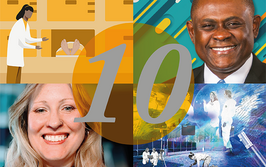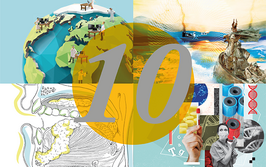I started using social media professionally around six or seven years ago; I thought it would be a good idea to use it to connect with pathologists that I met. If you think about it, you might meet someone at a meeting but then maybe you don’t see them again for a couple years. If you connect with them on Facebook, the next time you see them in real life, you feel like you’ve been friends forever.

I love to teach, and I had for a long time wanted to create a website or a blog to share interesting cases and educate others about them. But then I got to thinking… “What if I create groups on Facebook to share and discuss cases?” I knew friends who could join; what I didn’t expect was just how many people would follow suit. I set up two different groups in October 2013 (Dermatopathology on.fb.me/1L7n5Yg and Bone and Soft Tissue Pathology on.fb.me/1EHYJQG) and in less than six months each group had 5–6,000 members! There are now around 13,000 members in each of my groups; imagine having access to that many pathologists at your fingertips. These groups have now become great venues for me not only to share and to teach, but also to learn – and I learn a lot…perhaps even more than I teach. I see very interesting and rare cases shared almost daily from colleagues around the world. And some well-respected pathologists are involved, too, like Mark Wick, for example. After getting to know me on Facebook, Mark has repeatedly promoted me and boosted my “real world” career. He invited me to speak at the USCAP annual meeting dermatopathology session in 2014. He’s also given me multiple opportunities to write and collaborate with him and others. So I am seeing career benefits from my Facebook interactions.
Around the time I started my discussion groups, I also gave a small roundtable course at the CAP 2013 meeting on how to use social media. It sold out ahead of time, so I was asked to stay another day to do a repeat course – it also sold out! I then presented a “practice changers” session about Facebook and Twitter for Pathologists at USCAP 2014. It was meant to be a small session, but it became standing room only. I realized my pathologist colleagues really wanted to hear about how they could use social media professionally. In the past year alone, I’ve been invited to lecture on it over half a dozen times at meetings for pathologists and other medical specialties.
Less than a year ago, I joined a patient support group on Facebook for a disease called dermatofibrosarcoma protuberans (DFSP; on.fb.me/1KFCyMY). DFSP is a rare skin sarcoma that doesn’t behave like typical skin cancer, so a lot of people don’t know about it and patients struggle finding doctors who have heard of it. I have a lot of experience with DFSP and felt I was suited to working with this group. I decided to introduce myself to the members as a sarcoma pathologist who wanted to be more involved with patients and to answer general questions. Pip Çalışkan (group founder) and the other members welcomed me with open arms and were so thankful I was interacting with them. Pip told me: “No doctor or any other medical professional has ever contacted us before or tried to join our group in six years; you’re the first to show any interest in us.” I was blown away. How could we as physicians be missing out on this opportunity? I now know over 100 people with DFSP, and they tell me the same story: that doctors diagnosed their condition as a benign cyst and it wasn’t correctly diagnosed as a rare sarcoma until years later. They tell me things I never learned or only faintly grasped from my reading on DFSP in the medical literature. I think these patients teach me more about their disease than I teach them. I now have greater involvement in other sarcoma support groups.
My interaction with these people has been truly life-changing: in the compassion I feel towards all of my patients, in particular those suffering from rare diseases, but it’s also changed the way I practice. I think about these diseases more and I teach my medical students differently; I show them, and those that attend any of my seminars, pictures that patients have shared with me on Facebook. And when you show a graphic picture of angiosarcoma destroying a once beautiful woman’s face, and when you tell her story, let me tell you – stoic pathologists who have seen many bad things over their careers will still sit on the edge of their seats and listen. I’ve got a real drive to be a champion for people with these diseases and to help raise awareness about them. It makes it so real, what we do every day; it’s more than just a glass slide with a number on it, there’s a patient at the other end. And working with these groups reminds me of that continually. It has changed the course of my career, but even more, it really has changed my life.
My activities with the DFSP group have led to another amazing “first”. Members of the group (over 800 of them) asked that I conduct a research project on them; particularly because they wanted to know about a rare variant of their condition that medical literature is divided on. I thought it was a great idea, but I needed to get Institutional Review Board (IRB) approval. I was sure the IRB would hear “Facebook” and say “No way!” But not only was the head of our IRB excited about it, but they actually wanted to help me find a way to fund it, too! This was because it is “patient centered research” and unbeknownst to me, it’s a hot new trend. I’m now collaborating with another researcher and her team and with the DFSP patients to create one of the largest DFSP research studies ever undertaken. If you would have told me a year ago that I would be doing something like this, I would have thought you were crazy. And it would never have been possible had I not met these people on Facebook. Most of them had never met a pathologist, and few had any idea what we do. Not so anymore. Go ask these patients how they feel about the importance of pathologists, and they will tell you that we are crucial to patient care. So my work with these groups is also good for the reputation of our specialty, and I would love to see more pathologists get involved with other groups in a similar way. It would totally change how patients view us…and how we view patients. Everyone would win.
I’m less than three years into practice, and already I’ve met thousands of pathologists from around the world, I’ve been invited to co-author research, to sit on editorial boards, to speak in the US and internationally, and had numerous other amazing opportunities. Why? Is it because of the voluminous research I’ve done or the excellent training I’ve had? I’d like to think I’m a good pathologist who has done solid research, but no. It’s because “Oh hey, you’re that guy who posts about pathology all the time on Facebook and Twitter!” Social media has opened so many doors for me. So if people ask me why I “waste”all of my time on it, that’s why.
I understand why pathologists and other doctors might be hesitant when it comes to using social media; it’s only been around for about 10 years, so it’s still pretty new. Even I initially wondered what the legal risks might be. Here’s my take on it: When I comment to other pathologists about interesting cases in my discussion groups, I am careful to word my comments so that they are still useful, but not 100% committal. And when I’m talking to patients directly in support groups, I make it clear that I am not their doctor. Remember, these patients already have their cancer diagnosis, so there is minimal risk of me “misdiagnosing” them; I just try to help them understand their disease so they can better interact with the medical system they’re already plugged into. Contrary to the stereotype, many pathologists I know are actually outgoing people, but most of us are not used to talking to patients directly. It’s something very few of us have done, so add social media to the mix – something pathologists already feel uneasy about – and they’re thrown right out of their comfort zone. Interacting with patients is probably the kind of thing most will need to work up to, so I’d recommend not doing this on day one.
Thinking of risk, here is the way I see it: I look at skin biopsies every day and have to decide if they are benign nevi or melanoma. That is true risk. And yet I don’t wake up every morning and dread going to work over that. Social media is unfamiliar risk, but the risk of it truly going bad or getting you into real trouble is so infinitesimally small if you just use some basic common sense and professionalism.
If you want to get started, I suggest signing up to Twitter or Facebook – it’s so easy. I’ve developed a guide on how to use them, which will help (1). You don’t have to even post anything; just watch, soak it up and learn, and see how it works at first. Pretty soon, it’ll start to feel natural. And if you don’t like it, you can just close your account.
I spend a lot of time on social media because it’s really important to me. But it doesn’t need to take as much time as I spend on it; you could get involved while you’re eating lunch, standing in a queue… I refer you to a great example from a conference I was speaking at last year. During my 20 minute talk on social media, two well-known GI pathologists started up a GI pathology Facebook group using their cell phones! You don’t need to be a tech guru to get started.
It’s important to remember that it’s not about how many followers you have or how many “likes” you get; in the end, it’s about real-life relationships and being part of a community, and that’s one of the best things about social media. It’s just a tool that enhances and augments what we are already doing in “real life”. All of the big organizations are doing it now – CAP, USCAP, RCPath. I think the critical mass will draw everyone to it eventually. So why not start now and get ahead of the crowd?
I hope my story would inspire others to get involved. Social media is just too awesome and too powerful for us to waste.
Jerad M Gardner is an assistant professor of pathology and dermatology (specializing in bone, soft tissue, and dermatopathology) and the dermatopathology fellowship program director at the University of Arkansas for Medical Sciences in Little Rock, Arkansas, USA.
- JM Gardner, “Social Media Guide for Pathologists”, Pathology Resident Wiki bit.ly/1Aaxuiz
Jerad M. Gardner is an Associate of Geisinger Medical Laboratories and Section Head of Soft Tissue and Bone Pathology at Geisinger Medical Center, Danville, Pennsylvania, USA.




















